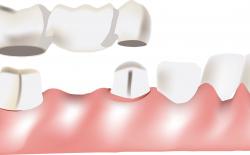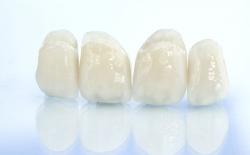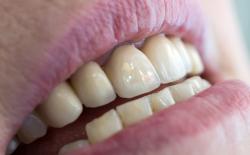Why is it called Maryland bridge?
There is an interesting story behind this name. It is not named after the state of Maryland, nor was it really invented anywhere in the state of Maryland.
Even though evidence shows that this technique has been used by dentists in the late 19th century, the modern version of Maryland bridges was probably invented by Dr. Stewart R Halbauer, a Glendale, Ohio dentist.
Later the University of Maryland popularized this technique, and hence, came to be known as the Maryland bridge.
What are the differences between a traditional and a Maryland bridge?
Adjacent teeth
- Traditional bridges: Require the entire coverage of the adjacent teeth which is used for supporting the bridge.
- Maryland bridges: They take support from a relatively smaller area from the adjacent teeth on the lingual side (inner side).
Tooth preparation
- Traditional bridges: More extensive tooth preparation or trimming of the adjacent teeth is required.
- Maryland bridges: Very little trimming or preparation is required.
Front vs back teeth
- Traditional bridges: They can replace both front or back missing teeth with good strength and greater support.
- Maryland bridges: They can replace front teeth with good esthetics but better to avoid for back teeth, where the masticatory forces (forces while chewing) are considerably high.
Number of missing teeth
- Traditional bridges: Preferred when a long bridge is required to replace more than 1 missing tooth.
- Maryland bridges: They are at greater risk of failure if used to replace several missing teeth in a row.
What materials are Maryland bridges made of?
The materials commonly used are metal, porcelain, and composites.
Metal: The tooth to be replaced is made up of metal like stainless steel substructure that is a non-perforated and sandblasted non-precious metal. It is not esthetically acceptable as it gives a metallic and artificial appearance.
Porcelain: These frameworks can be designed by wax-up mocks or using CAD-CAM. The main advantage of this type of bridge is the esthetics as well as good biocompatibility and lower levels of plaque accumulation.
The wings' extensions are comparatively thicker and larger than metal ones. Greater bulk is required for resistance to material fracture. Recently Emax, Cercon LAVA are used which gives amazing results, especially when used in front teeth.
Composites: Fiber-reinforced composites are preferred over traditional composites because of the greater strength. Areas predicted to have high-stress benefit from having fibers in one direction (unidirectional) which can improve the mechanical properties.
These bridges can be fabricated in the dental office during a single visit or in a dental laboratory.
The most popular solution nowadays is the use of porcelain/all-ceramic materials, as they bond well with the adjacent teeth, durable and have great esthetics.
Who can get Maryland bridges?
Maryland bridges are ideal for patients who are looking for a reliable and esthetic solution for replacing their missing front teeth. However, not all patients with missing teeth are eligible candidates for getting Maryland bridges. These bridges are offered to only those individuals who do not have cavities on the supporting teeth and have excellent oral hygiene.
Indications of Maryland bridge:
- Replacement of single missing teeth
- Missing teeth in the anterior or front region where esthetics is the main concern - a fixed type of porcelain Maryland bridge is indicated.
- When the adjacent teeth have laminates on the facial or outer surface where full tooth preparation is to be avoided.
- Good height and sound enamel of the abutment capable of supporting the bridge.
- A tooth in arch curvature - a fixed movable type of Maryland bridge is recommended.
- Good moisture control.
- Healthy oral cavity and good maintenance.
Contraindications of Maryland bridge:
- Several missing teeth in a row.
- Rear teeth where the forces while swallowing are very high.
- Crowded teeth, because of the higher chances of dislodgement of the bridge.
- Carious abutment - cavities in the abutment causes failure as the cavity progresses over time. Also, it mechanically weakens the tooth structure. Carious abutment should be treated by caries removal and restoration along with a full crown and bridge to replace the missing teeth.
- Deep closure of mouth - deep bite.
- Severely proclined front teeth, which are more prone to trauma.
- Crowding of teeth with little space for tooth replacement.
- Parafunctional habits like night grinding or bruxism.
- Sensitivity to nickel.
Maryland bridges are often used as a temporary solution to replace missing teeth for adolescents. More permanent solutions - like a traditional bridge or dental implant - are not recommended at a young age as the anatomy of the mouth and teeth are still changing.
Need a local dentist?
A great overview of the Maryland bridge procedure. Duration: 1:58.
How are they prepared?
The method of fabrication of Maryland bridges is slightly different from the other types of teeth bridges. This is because there is a minimal requirement for the preparation of the supporting natural teeth.
However, in some cases, a slight depression may need to be created on the inner surface of the teeth to enhance the retention of the bridge framework.
After necessary tooth preparation, your dentist will make an impression of the prepared teeth, which will be sent to the dental laboratory. Once the prepared Maryland bridge is received, it is attached to the teeth by using dental cement.
Advantages of Maryland bridges
- The most important advantage is minimal preparation of abutment: conservative preparation.
- Lesser risk of sensitivity and pulp exposure while preparation.
- Margins of the wings are above the gingival (gums) level which helps in easy removal of the plaque and easier maintenance of hygiene.
- No anesthesia is required for the procedure.
- Reduced chair time.
- Economical: Lower costs as compared to traditional bridges, where three crowns are placed to replace one missing tooth.
- Easy and quick to prepare: in comparison to other types of bridges, the process of fabrication of Maryland bridges is simpler and easier.
Disadvantages of Maryland bridges
Maryland bridges possess two esthetic limitations due to the use of a metallic framework for support and attachment.
- Limited usage: Maryland bridges are only suitable for use in very few clinical situations. Therefore, they are not used very commonly for tooth replacement.
- Metallic appearance: Our original teeth are naturally translucent. They show partially the color of the metal wings attached at their back surfaces, and hence, appear slightly darker than the other original teeth. Thus, an undesirable color mismatch can occur. To overcome this problem, frameworks of Maryland bridges are being prepared by using zirconia or other types of high strength ceramics.
- Maryland bridges usually don't last as long as traditional bridges.
- Cannot be placed if there is little space is available as space correction is difficult.
- Poor alignment of teeth is associated with a higher risk of failure.
- Compromised esthetics in posteriors where metal is used for higher strength.
Complications of Maryland bridges
The most important advantage - tooth-saving - also is the most important drawback of Maryland bridges. Since they are not attached as firmly as traditional dental bridges, they can become loose or even fall out.
These are the most common problems of Maryland bridges:
- Debonding
- Porcelain fracture
- Loss of adjacent tooth structure due to caries
- Framework fracture
- Minor rotation of the abutment
- Periodontitis in abutment and nearby region.
How much does a Maryland bridge cost?
The average cost of a single unit Maryland bridge is around $1,500 - $2,500.
The price depends on the number of wings and the number of missing teeth. The most common solutions are one unit bridges with one or two wings and two-unit bridges with two wings.
The usual cost of a single unit Maryland bridge (replaces one missing tooth) ranges from:
- USA: $1,500 - $2,500
- UK: £1,000 - £2,000
- Canada: $2,000 - $2,500
- Australia: $1,500 - $3,000
If you need to replace more than one tooth, the costs will be higher, however, the more teeth you replace with a Maryland bridge, the higher the chance of failure is.
Need a local dentist?
Frequenlty asked questions
How long does a Maryland bridge last?
The bridge lasts on an average for 5 years if maintained properly.
What is the success rate of the bridge?
The five-year survival rate of Maryland bridge is around 80% and the ten-year survival rate is around 65%.
Can Maryland bridges be removed?
Yes, they can be removed if any caries or sensitivity is noticed. This may indicate the underlying decay of the abutment tooth structure.
Can it be recemented?
Yes, it can be re-cemented. If a replacement is done after a long period of time, there might be changes in tooth positions like a tilting of the abutments in the space of the missing tooth. So if your bridge doesn't fill right, visit your dentist as soon as possible.
Can it be attached to a crown?
It can only be attached to the reverse three fourth crown where the inner or lingual or palatal surface is spared. It can also be placed on the teeth with lumineers especially which are placed in the front teeth for aesthetics purposes.
Can I have braces if I have a Maryland bridge?
Braces placement in orthodontic treatment leads to a considerable amount of change in teeth positions. If Maryland bridges are present in the mouth during the treatment, they might hamper the teeth movement or may change the direction of forces on the teeth, causing unwanted teeth rotations. Heavy forces may dislodge the bridge.
So it is better to place it once the orthodontic treatment is completed.
Can I go for MRI if I have Maryland bridge?
Yes, you can. Usually, metals interrupt the magnetic fields in MRIs. But in these bridges, the amount of metal is very small.
My bridge feels loose, what should I do?
The loose bridge might be because of many reasons, for example, due to caries, loss of adhesive, etc. Visit your dentist to find the underlying cause. If caries is present, they must be treated. If adhesive is washed off, the bridge can be recemented.
My Maryland bridge keeps coming off / falling, what should I do?
If it falls off, just keep it safely with cotton wrapped around and visit your dentist for oral examination and recementation. Even if the bridge is loose enough with very high mobility, it is better to remove it with your hands to prevent accidental swallowing or to prevent complete dislodgement while swallowing or speaking which may cause trauma to the oral tissues.
Can it cause gum recession?
Proper cleaning and brushing does not cause a recession and greatly improves the chances of success. The gum recession is directly proportional to the amount of bone loss, poor bone quality leads to gums recession. So it cannot be stated that gum recession is purely due to the bridge, but multiple factors including local (oral health and hygiene) as well assystemic factors (diabetic control, blood pressure, bone health, nutritional deficiency) might be responsible for it.
You might also be interested in:
Dental Bridges
Traditional dental bridges offer a more permanent solution. However, they require more trimming of the adjacent teeth.
Zirconia Crowns
Zirconia is often used for Maryland bridges. It is durable and bonds well with the supporting teeth.
E-max Crowns
E-max is probably the most esthetic method to replace a missing tooth. E-max is not only used for Maryland bridges but also used to manufacture crowns.


